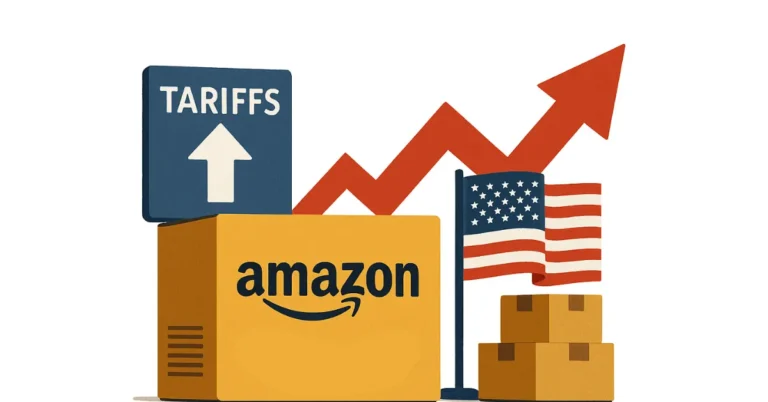A New Era for E-commerce
Tariffs are back in the headlines—but this time, the story for the U.S.-based Amazon sellers might not be so grim. As of May 2, 2025, the de minimis exemption, which allowed goods valued at or under $800 to enter the U.S. duty-free, is being eliminated for shipments originating from China and Hong Kong. While some saw this as another disruption in a complex global supply chain, many American sellers are welcoming the change.
Some are already seeing signs of growth.
The Amazon marketplace has long tilted in favor of international sellers, especially Chinese manufacturers who could ship goods cheaply and avoid duties. Now, that loophole is closing—and U.S. sellers are finding themselves on more equal footing. Based on what we’ve seen in recent conversations—and what sellers are saying online—the tide may be turning in favor of local businesses.
Leveling the Playing Field: No More De Minimis Loophole
The de minimis exemption had long provided an advantage to Chinese and Hong Kong-based sellers, allowing them to ship low-cost items directly to U.S. consumers without incurring import duties. This often resulted in lower prices that U.S. sellers found difficult to match.
With the exemption’s removal, these international sellers now face the same import duties as their U.S. counterparts. This change is expected to reduce the price disparity and give domestic sellers a better chance to compete.
In discussions on Reddit, some sellers have expressed optimism about this development. For instance, in a thread discussing the impact of the new tariffs, a user noted the challenges faced by Chinese sellers:
“Change brings both challenges and opportunity,” said Jake1125 on Reddit.
This sentiment reflects the broader expectation that the new tariffs will help balance the competitive landscape.
Less Competition = More Market Share for U.S. Sellers
The increased tariffs have led some Chinese-based sellers to reconsider their presence in the U.S. market. Facing higher costs, these sellers are either raising their prices or exiting the market altogether.
This shift presents an opportunity for U.S. sellers to capture a larger share of the market. With fewer low-priced competitors, domestic sellers can attract more customers and potentially increase their profit margins.
In the same Reddit thread, posts highlight the potential for U.S. sellers to benefit from these changes, as the competitive pressure from international sellers diminishes.
Real Seller Sentiment: “My Sales Are Up”
While comprehensive data is still forthcoming, anecdotal evidence suggests that some U.S. sellers are already experiencing positive effects from the tariff changes. With reduced competition from international sellers, these businesses report increased visibility and sales on platforms like Amazon. Obviously, this varies between specific categories and products.
This trend underscores the potential benefits of the new tariffs for domestic sellers, who can now compete on more equal terms and capitalize on the shifting market dynamics. It’s early days so getting this feedback talking to one of our sellers is encouraging.
Navigating the Upside: Why Agility Matters Now More Than Ever
Even with the positive momentum for U.S.-based sellers, this new tariff environment isn’t without challenges. For many, suppliers are demanding quicker payments due to uncertainty in global trade, tightening production timelines, or even re-negotiating terms altogether.
This is where agility becomes a strategic advantage.
Some sellers are already adjusting their business models: sourcing more locally, raising prices slightly, or doubling down on high-converting SKUs. But even the best plan falls apart if you don’t have access to the cash flow needed to move quickly.
A recent eCommerce industry report highlighted that manufacturers are pushing for quicker payments, with tariffs being one of several factors squeezing the cash conversion cycle. The report suggests that this evolving environment is distinguishing sellers who are merely responding from those who are prepared, with the key difference often lying in how fast they can secure and reinvest capital for growth.
How Payability Helps Sellers Stay Agile in Choppy Waters
At Payability, we’ve always believed that speed is strategy—and today’s environment proves it more than ever.
As market dynamics shift, sellers who can act quickly have a clear advantage. Whether it’s placing a larger inventory order to outpace competitors, investing in PPC during a traffic surge, or negotiating better terms with suppliers, having fast access to your earnings can be the difference between growth and stagnation.
That’s why Payability offers:
- Instant Access to Your Marketplace Payouts so you’re not waiting weeks for capital you’ve already earned.
- The Payability Seller Visa® Card gives you fee-free access to your sales balance.
- Daily Cash Advance options (based on your sales history), with no credit checks, are perfect for managing seasonality or seizing sudden opportunities.
In moments of disruption, flexibility is power—and we’re here to help you stay one step ahead.
Apply today and get pre-approved so you’re ready when needed. Click here to get started.
Conclusion: The Future Belongs to the Agile
The elimination of the de minimis exemption is reshaping the Amazon marketplace in real-time. While some international sellers are scaling back or raising prices, U.S.-based businesses are seeing doors open that have long been closed.
For many domestic sellers, this is more than a policy shift—it’s a moment to gain ground, recapture market share, and build more sustainable, margin-positive brands.
But to capitalize on this momentum, you’ll need more than optimism—you’ll need operational agility and financial flexibility. That’s where Payability can help.
In choppy waters, the most agile ships don’t just survive—they lead.
Let us help you turn this market shift into a growth opportunity.


